Introduction
Spotted neck doves, Spilopelia chinensis, are commonly encountered in Serangoon Gardens, Singapore. Their cooing can be heard originating from trees and roof tops. They nest on my neighbour’s window sills, my window sills, my roof space and in my Golden Chalice Vine (Solandra longiflora). Javan mynah birds (Acridotheres javanicus) were often seen raiding/attacking these nests, resulting in failed nestings.
Early April 2023, a pair of these wild spotted neck doves brought twigs and tried to construct a flimsy nest on one of my horizontal roof beams (Wells also reported this) on the first-floor balcony. This location is easily seen from my first-floor workroom and I noticed the twigs falling off the smooth, slippery beam repeatedly. This location is approximately 2.3 m high from the balcony floor and 4.0 m from the workroom window. They persisted in this heartbreaking, futile work for two days, then flew off to take a rest. So I aided this hardworking pair of birds by tying a cardboard box to the beam and placing their fallen twigs inside. Well, the birds came back, and happily accepted the box nest. Mother bird, feeling that time was running out, quickly arranged the twigs into a comfortable nest and laid 2 eggs. The rest is history. One chick hatched and subsequently fledged on 12 May 2023.
This pair of birds are so happy with this situation that they came back repeatedly and to this date, has successfully raised 5 chicks in total. In this post, I note the interesting events and observations throughout the breeding season.
Methodology
I observe the goings-on in the nest from my room window, at times standing on a stool to obtain eye-level images/videos of the nest. Observations were made periodically as I go about my day’s activities and I made a special observation if I hear calls from the adult birds. When I noticed that the parent birds were not in the nest, I climbed up a short ladder to peep into the nest and take pictures/videos. I do not touch the nestlings or attempt to engage the adult birds. The adult birds are used to seeing me looking at them through the window and photographing them (no flash) and slowly lost their skittishness whenever they spot me in my room. They also feed in my garden and over time I spotted juvenile birds at different maturity stages (amount of spots on their neck) in my garden.
As I observed them, I started to comprehend their behaviours and calls.
Breeding notes
In the first post, I noted that the female and male adult birds have slightly different markings on their faces, particularly the dark line from their eyes to the base of their beak. I also noted their favourite perches. To make writing easier I christen the male bird Andy and the female bird Betty.

I made notes throughout the 7 months of observations and present them in the table below, recording the incubation period and the nesting period. The dates when egg was first laid, when egg hatched and when nestling fledged are often estimates. In some cycles, I was sure of the dates because I witnessed the event and at other times I am able to document with photos/videos. In other cycles, I note the presence of the nestling(s) in the nest and an empty nest the next day. The first day nestling is slightly longer than the egg, the eyes are closed (it takes about 3 days for the eyes to open). In cycle 4, I managed to videograph Betty flying off with the broken half egg shell on day of hatching. Approach of fledging day is indicated by the nestling sleeping alone in the nest at night, usually for about 4 nights. One to three days before fledging the chick will be restless and may respond to the parent birds’ incessant calls from roof-tops and garden. The nestling may get out of the nest box and sit outside of nest. In cycle 5, I saw the nestlings fledging when I peered through the CCTV camera at 12 pm that day. As the event occurred suddenly, I was unable to capture it digitally.
The dates and observations in red fonts are events captured in videos or personal observations. As such, some of the data are indicated with a question mark as they are estimates. The hiatus period in the table refers to the number of days between the fledgling(s) leaving the nest and Betty laying for the next cycle.
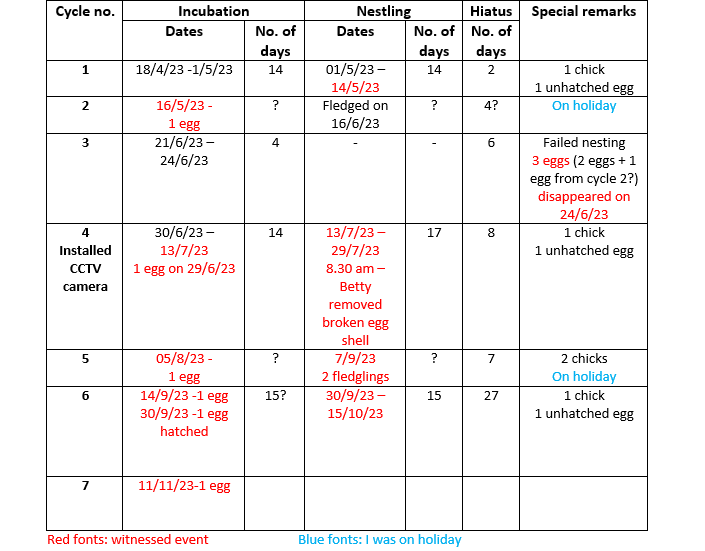
Table 1: Summary of egg-laying, hatching, nestling care and fledging dates of 6 cycles observed.
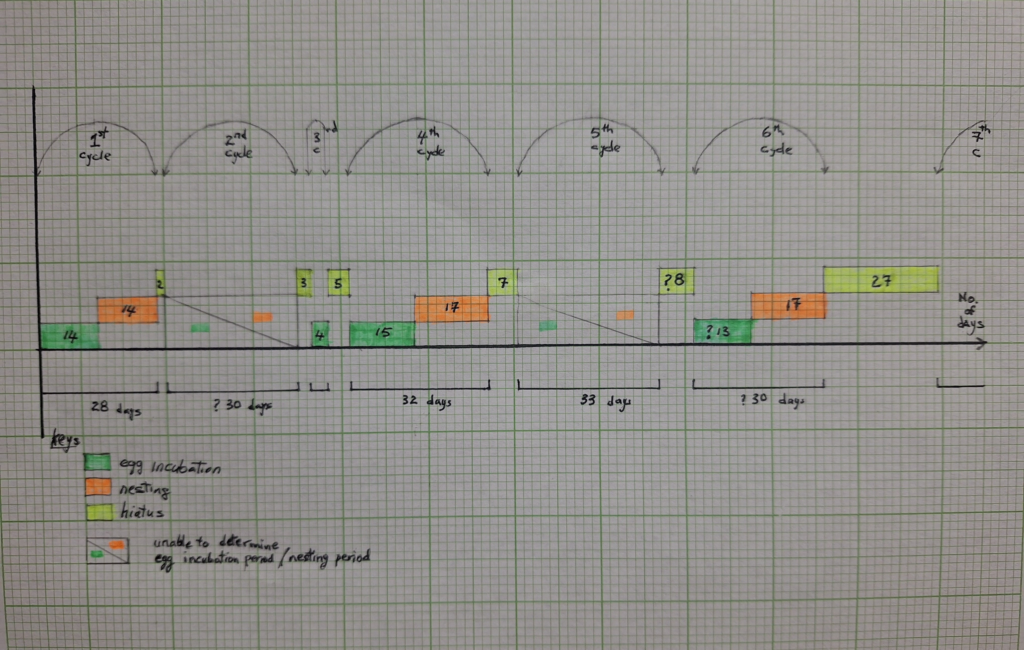

Before each breeding cycle, Andy brings twigs to the nest and coos loudly. Betty goes into the nest and arranges the twigs. She is then seen sitting in the box for short periods of time and flying off. Then, one day she stays in the box continuously, leaving only when Andy comes in. Both birds take turns brooding the eggs in the daytime, but at night Betty sits on the eggs. In nest building, there is no sharing of work but in specialization. Betty is the the one who arranges the twigs into a comfortable nest, Andy is the one who brings her the twigs at short intervals (1 minute ) initially, then the time gradually lengthens until he disappears altogether. In one episode Betty was done with arranging all the available twigs in the half finished nest, and Andy still had no-show. Impatient Betty hops on and off the front edge of the box nest a few times, looking out for Andy. After 20 minutes, she flew off to look for the ‘good-for-nothing’ Andy. Over time, we realised that hard-working Andy was looking after, feeding and guiding the newly-fledged juvenile and gathering twigs for Betty.
The pattern of nest-sitting changes to Betty taking the night shift starting about 4 – 5.30 pm and lasts till 7.30 am. She will leave the nest in a hurry irregardless of Andy’s presence. She may have cooed urgently and loudly before Andy appears. Sometimes, Andy takes over from Betty without the loud calls. Andy would normally call at about 3.30 pm. Betty may or may not appear. Andy would leave the nest unattended until Betty appears from approximately 4.00 – 6.30 pm. This pattern is repeated during 5 cycles I observed. Betty has also been seen occasionally relieving Andy for short periods of time between 10 am – 6.30 pm.
Changeover is often a quiet affair. The relieving parent flies to my roof top, looks nervously around for some time, then flies to my window sill and stays there briefly before flying to the nest. The parent in the nest dashes out of the nest hurriedly ( toilet break) when the relieving parent’s presence is detected.
After understanding this couple’s goings on, I realised that the adult not incubating the eggs was actually hard at work feeding, guiding and teaching the just fledged chick how to fly. As the fledgling gained experience in flying, the youngster and a parent can often be seen feeding in my garden. With the passing days, the parent may look on from a vantage point, frequently from an electrical wire or a roof top. The parent calls and the juvenile flies from tree branch to tree branch, roof tops, fences etc.
When the egg hatches, the parent will stand over the chick and looks at it tenderly, occasionally prodding it softly. The adult can be seen to open the downward pointing beak slightly and remain this way for some time. I think crop milk is trickled into the beak of the young chick. This takes place for short periods and repeatedly many times a day. By the third day, the parent can be seen to regurgitate food into the chick’s beak. From the sixth day onwards, the chick can be seen to stand up to receive the food. It would poke it’s beaks into the parent’s slightly open beaks. The parent then regurgitates food from its crop and into the half open beaks of the chick. The chick would push against the parent quite vigorously. As the chick grows larger, it begs and pecks continuously at the parent’s beak. Later, the chick flaps its wings while being fed and one wing would tap the parent’s back continuously. Both parents take turns to feed the chick.
The hatchling’s phenomenal growth rate during the first week is believed to be due to growth – promoting factors found in the crop milk. (Handbook of the Birds of the World Vol. 4 ©1996, page 94).
Approximately four days before the chick fledges, Betty does not stay in the nest at night. The two parents take turns to feed the chick in the day but for shorter lengths of time . I once timed the feeds and recorded one feed lasting 30s and another lasting 1 minute. The parents would take turns to call loudly from the surrounding roof tops or below the nest height, often out of sight of the chick. The chick would pace restlessly in the nest, flap its wings and may respond to the adults’ calls. It may sit at the edge of the nest and later step out of the nest and sit around, taking in the surroundings. Hence, the parents encourage the chick to fly by getting the chick to feed outside the nest. A third incentive for the chick to fly is possibly the pigeon louse-fly. In one instance, I counted up to 10 louse-flies on a chick. These are blood-sucking flies, which most probably cause a lot of itch and pain to the baby chick. And since the chick is the only one left in the nest, it has to bear the full attack of the louse-fly army.
On the day the chick fledges, usually in the late afternoon, it suddenly flaps its wings and lifts off nervously, making a loop flight of about 1m distance from nest. It would then sit nervously for half an hour to three hours (varies with fledgling). Then suddenly, it flies out to a tree and stays there. The parents would call loudly from their vantage points and Betty would fly to the chick, calming the shaking chick. She would preen the chick’s feathers, feed it for a few seconds, coo to it softly and sit with it. Andy would call loudly from his favourite roof perch for the rest of the day. The chick would attempt a few short flights, flying erratically from tree to tree or to overhead electric wires. The chick always rests for a long time between flights. By dusk (~7.00 pm), Andy stops calling. The chick does not return to the nest anymore. I do not know where Andy, Betty and the fledgling spend the nights. However, the twin fledglings from cycle 5 were seen sitting in the nest the day after they fledged but not staying in the nest at night. The nest remains empty until Betty lays eggs for the next cycle.
Over the next one week, Andy can be seen accompanying the fledgling during its practice flights. Loud calls from Andy will also be heard throughout the day. I often spy a fledgling improving its flight mastery over the next week and the frequency of Andy’s loud calls decreasing. Betty will fly after the fledgling too if she has not started laying for the next cycle.
Cycle 1
Read https://besgroup.org/2023/06/15/spotted-neck-dove-nestling/ on my write-up of this successful breeding.
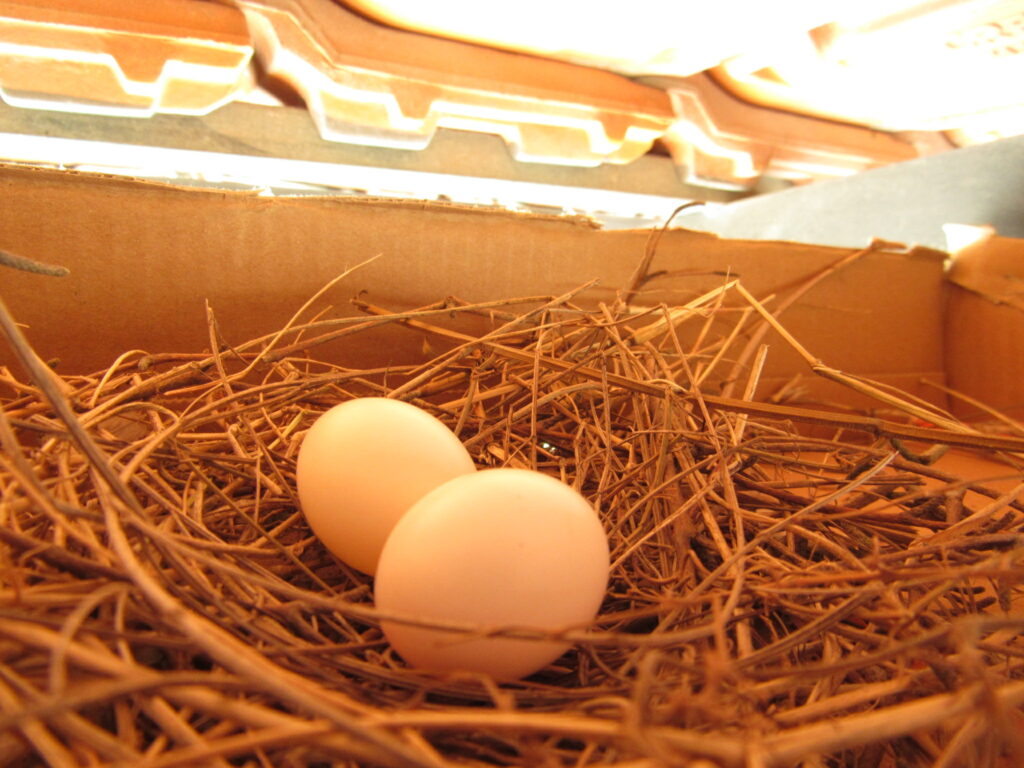
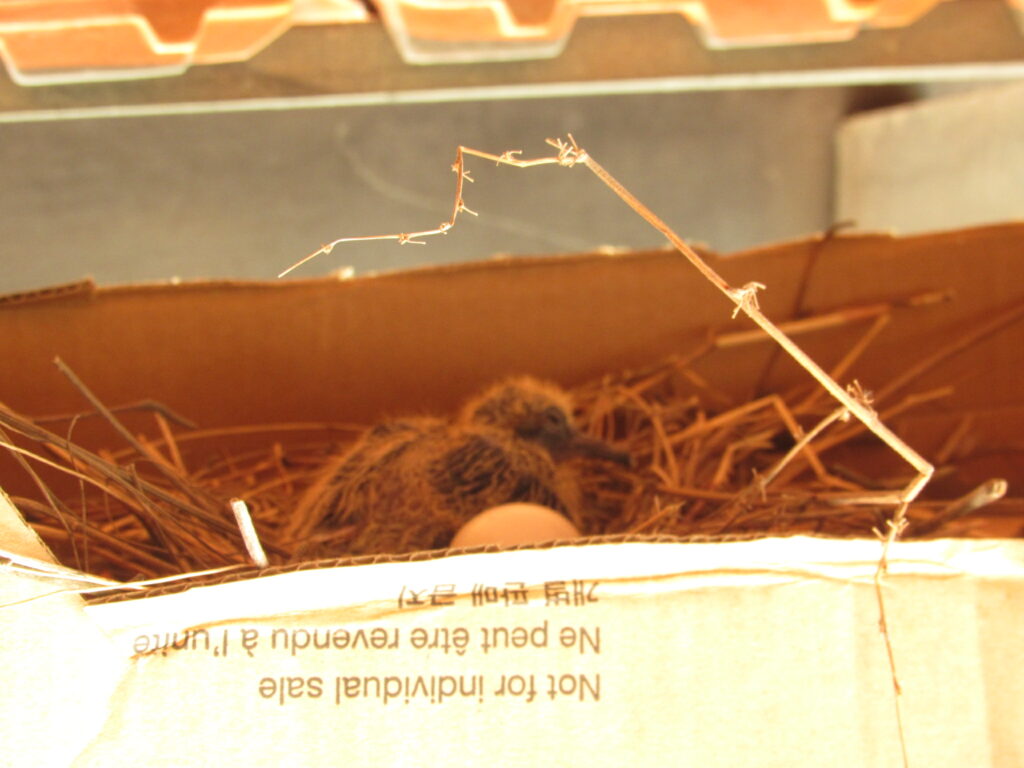
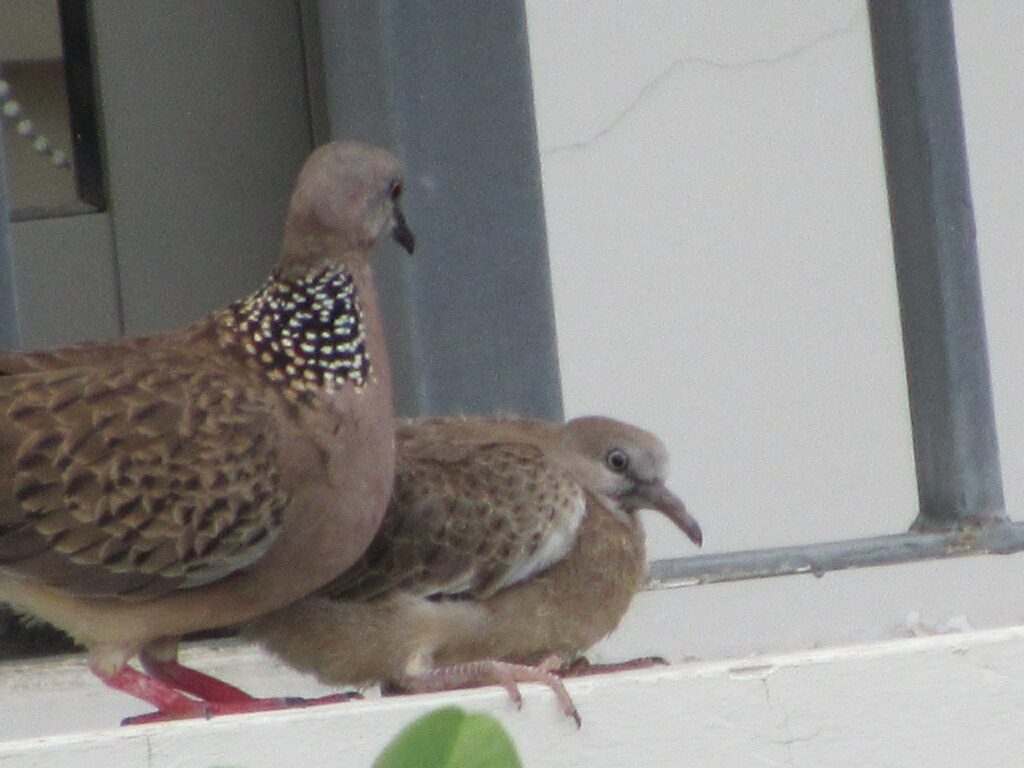
Cycle 2
I checked the nest box just before I left Singapore on 16 May 2023. To my surprise I saw a single egg in the nest. I have no knowledge of the outcome of this cycle. If the egg(s) had hatched, the chick(s) would have fledged ~ 16 June 2023.
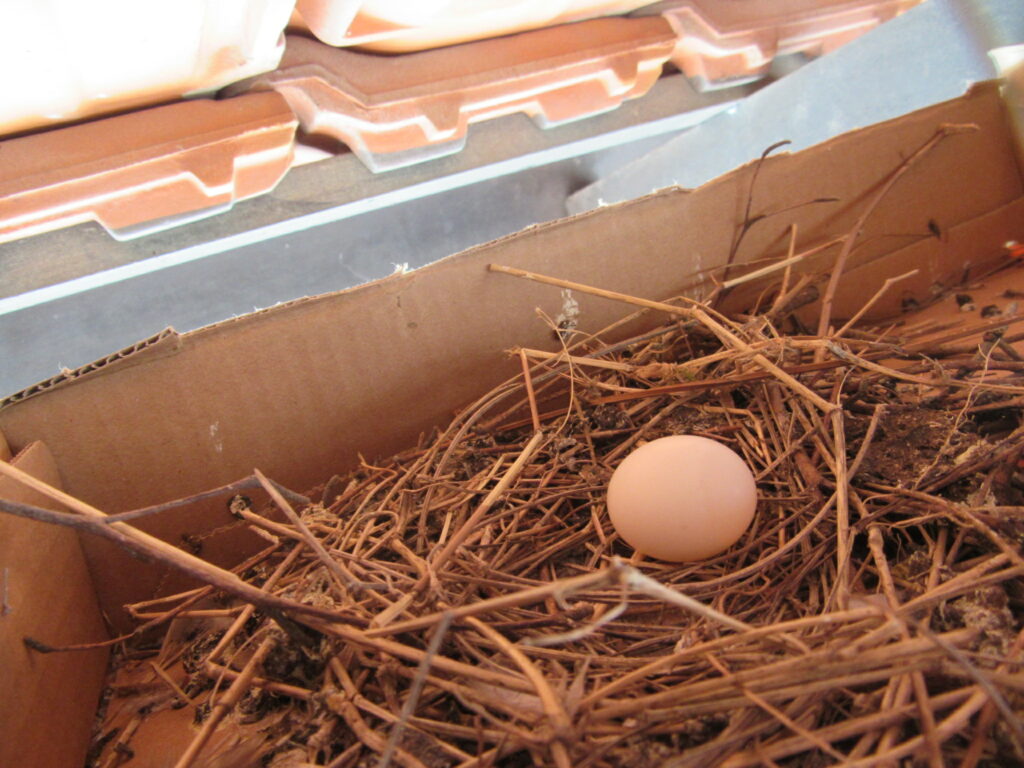
Cycle 3
I returned home from my holiday on 20 June 2023 and noticed Betty brooding in the nest. My height challenged wife climbed up the ladder (21 June 2023), dipped her right hand into the box and felt 3 eggs inside! We assume that Betty was actually brooding 3 eggs, 1 unhatched egg (cycle 2) and 2 eggs from cycle 3. We deduce that 1 chick fledged in cycle 2.
On 24 June 2023, I noticed that Andy and Betty were not brooding the eggs. I climbed up to peek into an empty box!! Nobody had seen or heard anything unusual that morning. However, I did notice a Javan mynah near the empty nest. Is this the egg thief?
Cycle 4
I installed a CCTV camera to observe the nest goings-on. The observations for this cycle were made from direct observations through the room window and the CCTV.
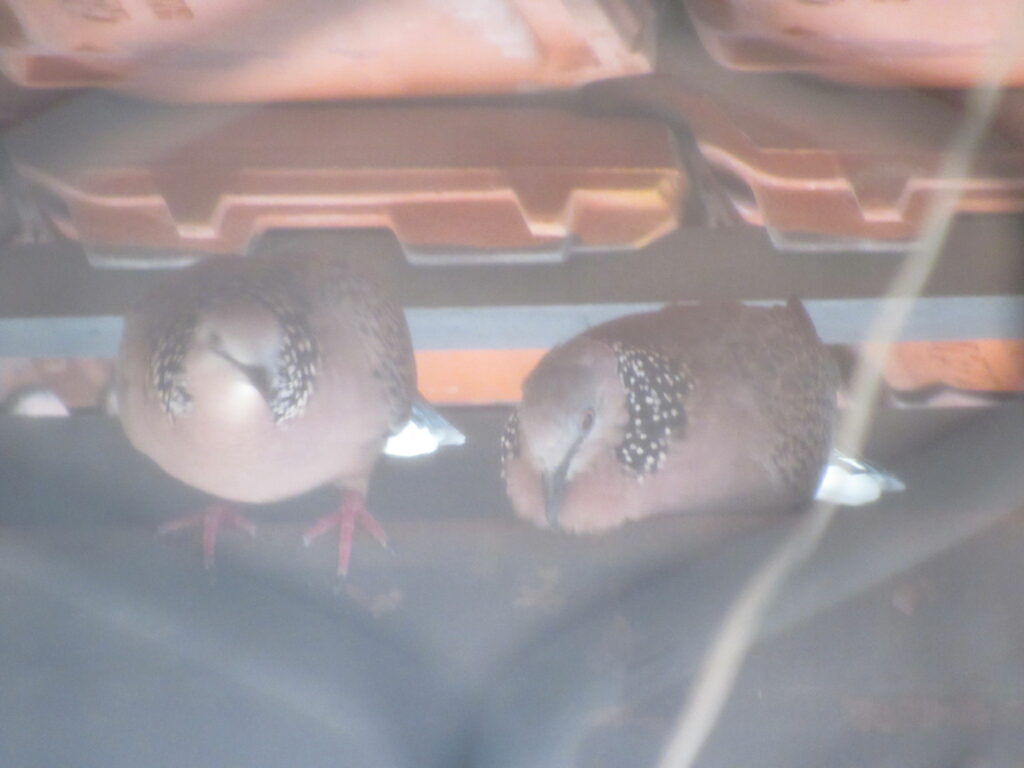
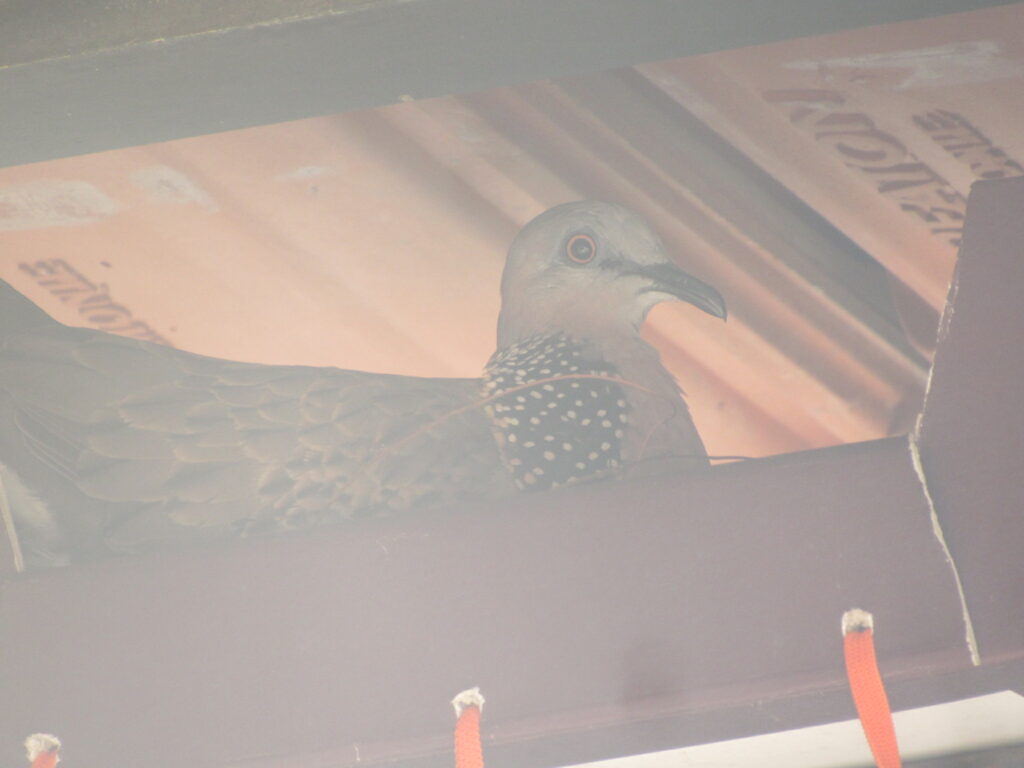
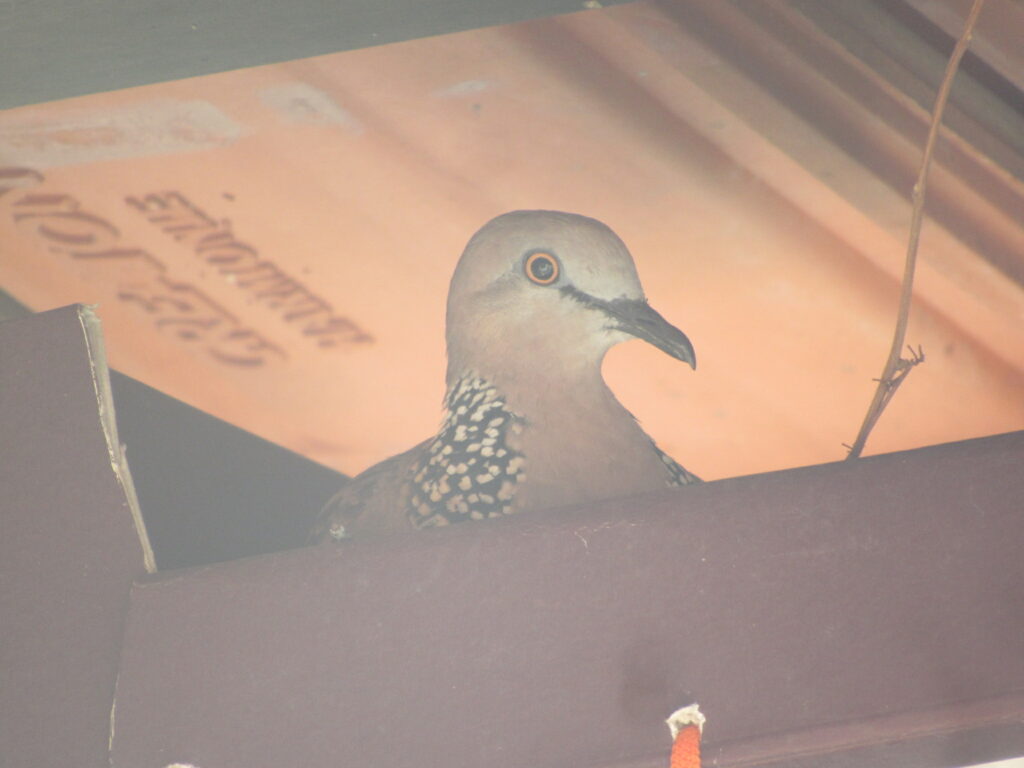

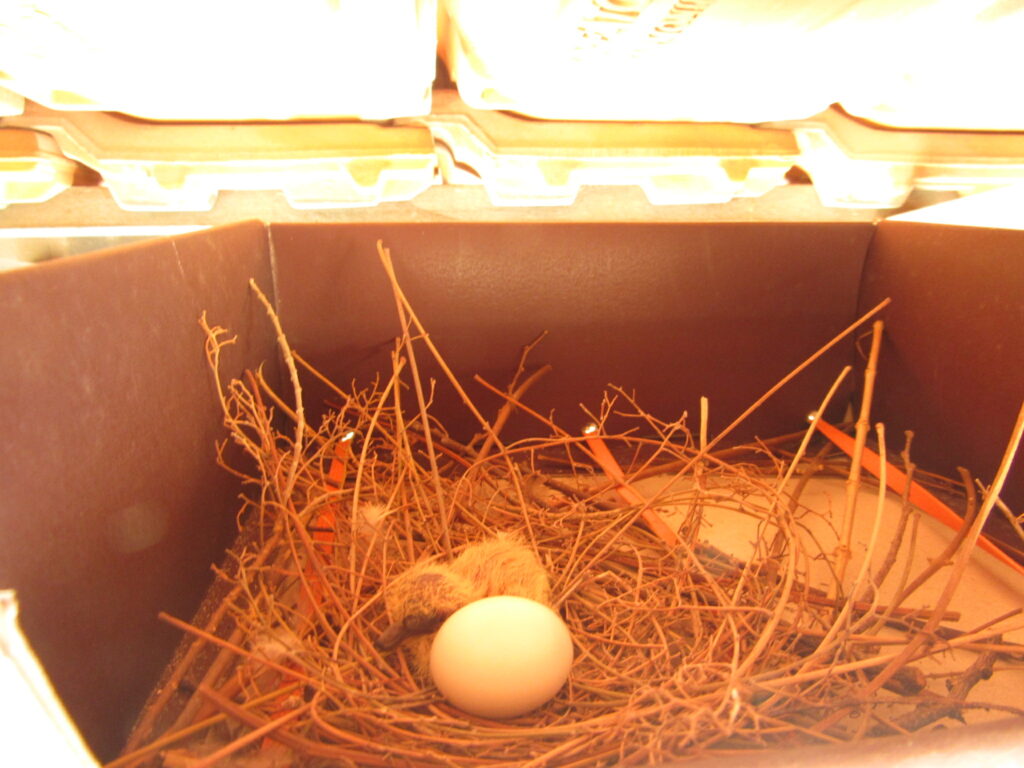



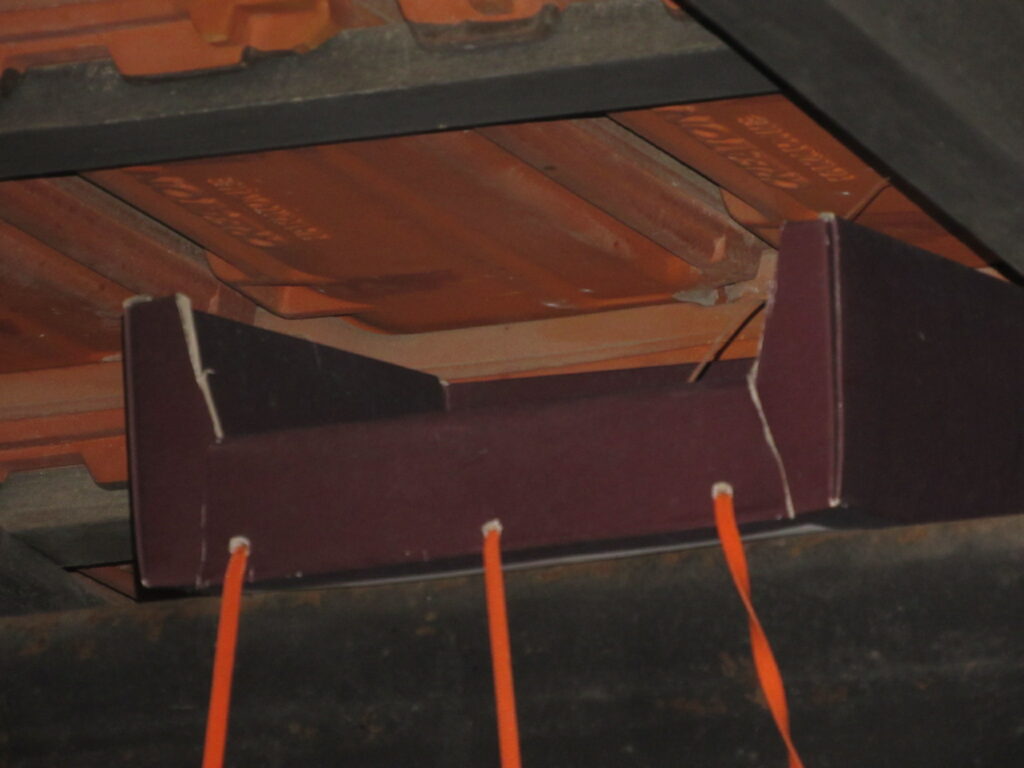
Cycle 5
I travelled from 5 August 2023 – 20 September 2023 and was pleased with the quality of photos and videos obtained through the CCTV camera. Before I left for the airport I climbed up to peek at the nest when the adults were absent. One white egg was sitting prettily inside! All the photos and videos from then on in this cycle were CCTV footages.
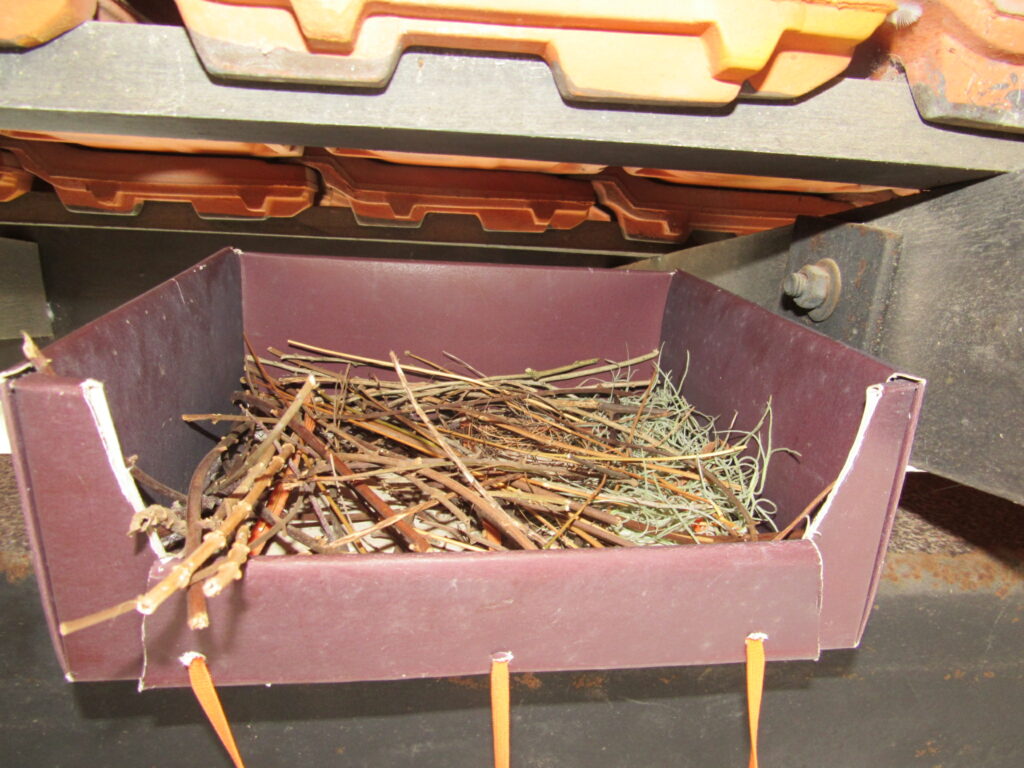

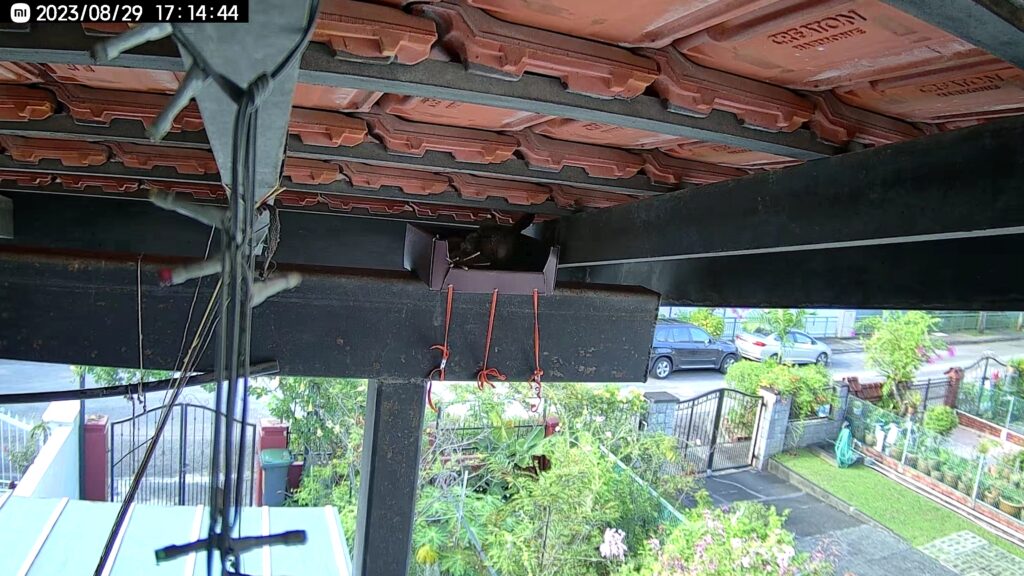
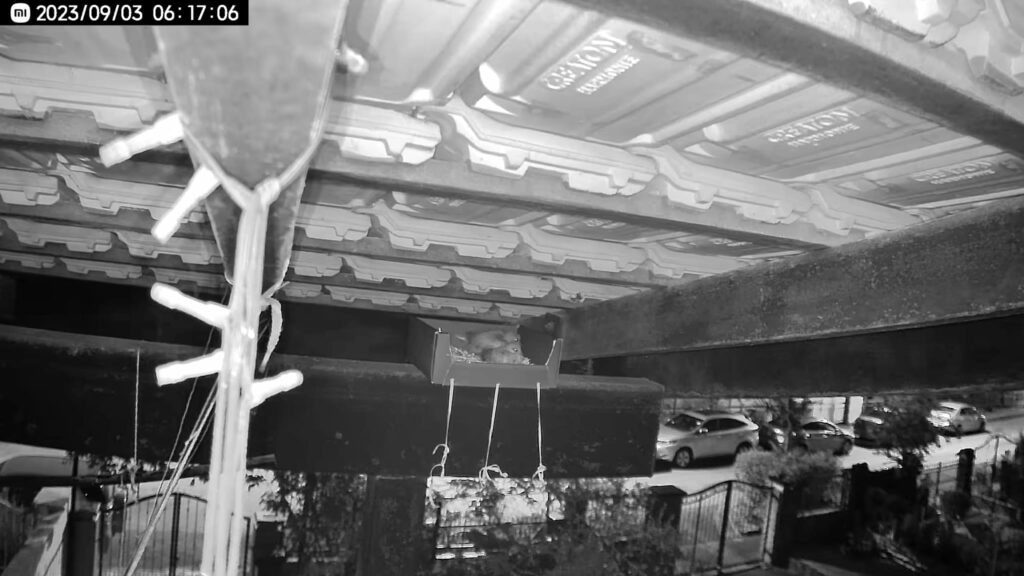


Cycle 6
Through the CCTV, I noticed the adult birds bringing twigs to the nest from 12 September 2023 onwards.
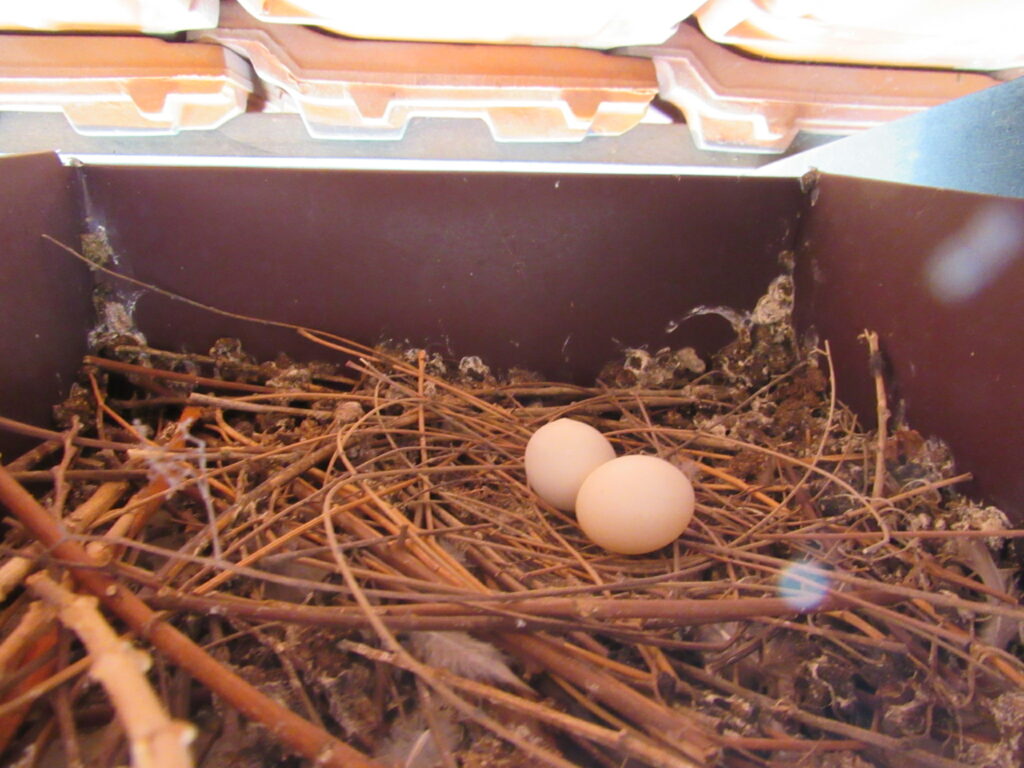

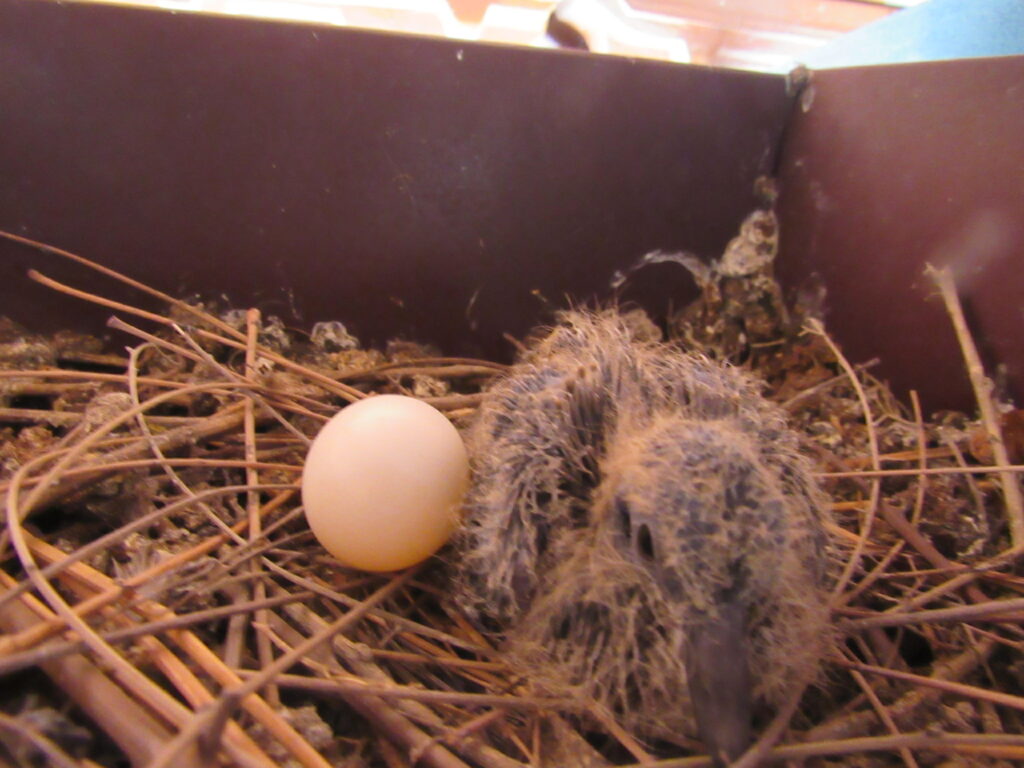
Discussion
The egg incubation plus nurturing of chicks is estimated to be between 28 and 33 days. The rearing of the twins in Cycle 5 took 33 days, probably because of a slightly slower growth and development rate of the twins. The hiatus period increased with later cycles, changing from 2 – 8 days during the period April – September. This could be due to Betty getting older and needing a longer period to replenish her body’s depleted store of nutrients as a result of the hectic rate of the previous cycles.
Currently Andy and Betty are taking turns sitting in the nest brooding the egg laid on 11 Nov. ( 7th cycle). The surprising point is that this time the hiatus is an exceptionally long 27 days. Could Betty have gone to another nest, laid an egg which ended in a disastrous nesting event? However to put things in perspective, Andy and Betty were outside the box nest site on 2 Nov. Andy hopped into the box and started cooing, telling Betty it is a nice new clean box with a bundle of ready twigs, sans louse-flies. Betty came near and peeked into the box but was not seen inside it until 7 Nov. Over the following 3 to 4 days, the empty nest was seen in increasing stages of completeness. Then on 11 Nov., 9.06am an egg was seen in the nest.
At the time of publication of this post, Andy and Betty are brooding and I expect the egg(s) to hatch any time now. Cycle 7 and beyond will be documented in future posts.
Between April and October, Andy and Betty had raised 5 + 1 (Cycle 2, inferred) offspring.
References:
- The Birds of the Thai-Malay Peninsula by David R Wells Vol. One ©1999
- An introduction to Malayan Birds by G.C. Madoc ©1956
- Birds of Singapore and South-East Asia by John Bucknill & F.N. Chasen ©1990
- A field guide to the Birds of South-East Asia by Ben King, Martin Woodcock & E.C. Dickinson ©1975
- Handbook of the Birds of the World Vol. 4 ©1996
- https://besgroup.org/2014/03/23/nesting-behaviour-of-the-spotted-dove/
Addendum on 15 December 2023: One chick hatched in cycle 7. The chick was predated on 10 December 2023, the day it was expected to fledge. Predator: unknown, but suspect Indian mynahs Acridotheres javanicus.








One Response
Hi, I am leaving a message here for anyone who might be interested to pick up two unhatched (more than 16 days) spotted doves eggs for research purposes. The nest is on my balcony and the parents have just abandon their brooding. 30/12/23 10.30am. Please email [email protected]